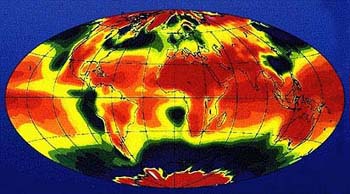|
Clouds and Climate Change
Until recently, scientists did not know whether clouds had a net cooling or
heating effect on global climate. Clouds reflect solar radiation, which tends to
cool the climate, but they also help contain the energy that the Earth would
otherwise emit to space, which tends to warm the climate. Measurements made in
the 1980s by NASA's Earth Radiation Budget Experiment (ERBE) satellite
demonstrated that clouds have a small net cooling effect on the current global
climate (Figure 2). As human-induced processes (e.g., deforestation, release of greenhouse
gases) increasingly affect our climate, it becomes more critical to gain a
precise understanding of how climate variations can alter the physical and
chemical processes that govern cloud formation and dissipation.

Figure 2: Cloud Radiative Forcing determined from 1985 to 1986. Net
cloud forcing is the result of two opposing effects: (1) greenhouse heating by
clouds (or positive forcing) — clouds trap heat coming from Earth's surface
that would otherwise be lost to space, and (2) cooling by clouds (or negative
forcing) — clouds reflect incoming solar radiation back to space. The
relatively large areas where cooling is the greatest are represented by colors
that range from yellow to green to blue. In some areas, the effect of the clouds
is to produce some warming as shown by colors that range from orange to red to
pink. Overall, clouds have the effect of lessening the amount of heating that
would otherwise be experienced at Earth's surface-a cooling effect. (Earth
Radiation Budget Experiment data on the Earth Radiation Budget Satellite and the
NOAA-9 satellite. Data processed at NASA Langley Research Center; image produced
at the University of Washington).
We must also determine to what extent resulting changes in cloud patterns
will affect climate as a result of their effects on Earth's "energy
balance." If we measure the total amount of solar energy Earth receives
from the sun, then we deduct from that number the total amount of
sunlight reflected and the heat emitted from Earth, then we arrive at a
number referred to as Earth's "energy budget." Because global
measurements to date suggest that the amount of incoming radiant energy
is roughly equal to the amount that is outgoing, we say there is an
"energy balance." But a small percentage change in cloud cover could
have a significant effect on Earth's energy balance.
A key to predicting climate change is to observe and understand the
global distribution of clouds, their physical properties (such as
thickness and droplet size), and their relationship to regional and
global climate. Because clouds change rapidly over short time and space
intervals, they are difficult to simulate in computer models and,
therefore, their contribution to climate change is difficult to quantify.
Improving our understanding of clouds and refining our predictive models
of their behavior will also aid weather forecasting.
Current global change models are hampered by insufficient understanding
of certain fundamental physical processes. NASA's Terra spacecraft will
obtain a variety of precise measurements of cloud properties to feed
improved climate models. Terra will yield improvements in our knowledge
of cloud water droplet and ice crystal content, as well as how the
feedback loops between Earth's air, land, and ocean work from day to day.
next: Surface-Based and Satellite Observations
back: How do Clouds Form?
|
|

- Changing Global Cloudiness
- How do Clouds Form?
- Clouds and Climate Change
- Surface-Based and Satellite Cloud Observations
- Terra and Cloud Observations
|


